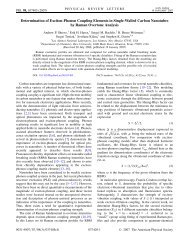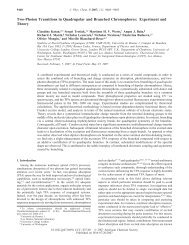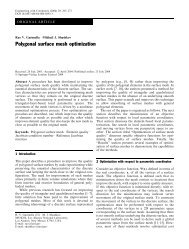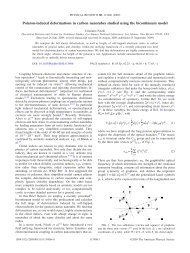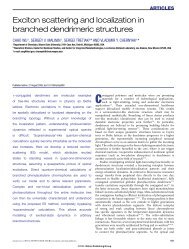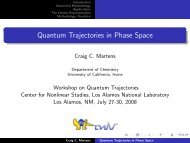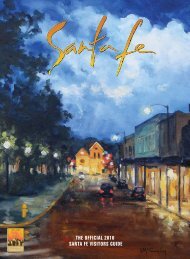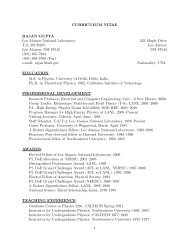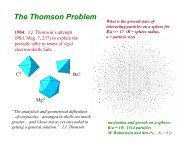Research Highlight – Shrinivas Kudekar
Research Highlight – Shrinivas Kudekar
Research Highlight – Shrinivas Kudekar
Create successful ePaper yourself
Turn your PDF publications into a flip-book with our unique Google optimized e-Paper software.
<strong>Research</strong> <strong>Highlight</strong> <strong>–</strong> <strong>Shrinivas</strong> <strong>Kudekar</strong><br />
All my research papers have been published in internationally reputed conferences and journals,<br />
which have a stringent, anonymous, peer review process, judging scientific importance,<br />
originality and clarity of exposition. My major research accomplishment in the field of information<br />
science is via the very recent work threshold saturation via spatial coupling<br />
([1, 2, 3, 4, 5, 6, 7, 8]).<br />
Introduction to Information Science<br />
Communication is an indispensable part of daily human life. Examples of communication<br />
devices include mobile phones, Internet or telephone networks. With these systems we communicate<br />
messages across the world. Other examples of communication devices include DVDs,<br />
iPods, hard disk drives. These electronic devices store digital data and can then be “replayed”<br />
at any point of time.<br />
Any communication channel is inherently noisy. This means we can never transmit information<br />
perfectly. Random signal fluctuations are the characteristic of all electrical circuits.<br />
These corrupt our information. For example, the signal from the mobile phone is distorted due<br />
to interference from other phones, buildings or trees. Sometimes playing back music or video<br />
from a DVD might not be perfectly possible if there is a scratch or dust on the DVD. The field<br />
of information science, and more specifically coding theory, makes it possible to communicate<br />
digital information reliably across any noisy media such that the original information can be<br />
retrieved.<br />
In his seminal paper on mathematics of communications in 1948, Claude Shannon, formulated<br />
a theory of digital communication which forms the basis of all modern communication<br />
systems. Shannon introduced the notion of capacity of a noisy channel: we can remove the<br />
channel errors and recover the information perfectly as long as we are transmitting at speeds<br />
smaller than the capacity of the channel. If we transfer above the capacity of the communication<br />
channel, the receiver will not be able to remove the errors introduced by the channel no<br />
matter how sophisticated it is. In other words, one can think of the capacity as a fundamental<br />
limit of communication across any noisy media.<br />
The goal of coding theory is to develop techniques, called as “error-correcting codes”, which<br />
allow us to communicate information reliably over noisy channels. In more technical terms, the<br />
transmitter (your mobile phone) encodes the information message in a codeword. The codeword<br />
protects the message against the noise of the communication channel. At the receiver, the<br />
codeword is then decoded to retrieve the original information message. Every communication<br />
device has limited computational and energy resources due to their size. Thus the key point<br />
of coding theory now is to develop codes that are not complex, so that they can be easily<br />
implemented in our electronic devices. This is a hard problem and it is only fairly recently,<br />
around 1995 - 2000, that a combined effort of coding theorists, mathematicians, computer and<br />
electrical engineers has resulted in invention of codes that allow us to do so.<br />
My Main <strong>Research</strong> Contribution: Spatially Coupled Codes<br />
As the demand for faster communication increases, the dream of transferring information near<br />
the Shannon capacity remains elusive. Thus the ultimate goal would be to develop encoders<br />
and decoders which are fast and we are able to communicate reliably at the capacity, that<br />
1
is, we are communicating as fast as possible. This has been a long standing open problem<br />
and my main research contribution, presented in [1], has made significant progress to solve<br />
this. In our research article we study a particular class of codes known as “spatially coupled<br />
codes”. We formulate a general mathematical theory, which we call as threshold saturation<br />
via spatial coupling. Using this theory we show that these codes can be used to transmit<br />
information at speeds extremely close to the Shannon capacity, using encoders and decoders<br />
which are very fast and easy to implement. We also show that these codes are universal:<br />
they can be used without knowing the exact nature of the noisy channel. Thus, we show that<br />
spatially coupled codes hold the tremendous promise of achieving simultaneously the dream of<br />
transmitting at Shannon’s limit, practical implementability and universality. Spatially coupled<br />
codes thus stand to fundamentally alter the design of communication devices by making them<br />
smaller, faster and more reliable.<br />
Apart from the practical significance of these codes in design of digital communication systems,<br />
our theory of threshold saturation is being used currently to design systems and analyze<br />
problems in computer science, signal processing and statistical physics. Thus our research<br />
has generated interest across many scientific disciplines. After the publication of our work<br />
[1], an entire session has been devoted to spatially coupled codes at the Information Theory<br />
and Applications (ITA) conference held once every year at the University of California at<br />
San Diego, USA, (http://ita.ucsd.edu/workshop/11/talks/). This is a premier conference<br />
in communications which is attended by over 500 researchers across academia and industry<br />
throughout the world with focus not only on the theoretical aspects but also on various important<br />
applications like bioinformatics, medical imaging and cyber security. Also an entire<br />
workshop on spatially coupled codes was held at the Tokyo Institute of Technology, Japan,<br />
(http://www.comm.ss.titech.ac.jp/) and will be held at the École Polytechnique Fédérale<br />
de Lausanne (EPFL), Switzerland, (http://caact.epfl.ch/index.php/Workshop). These<br />
workshops will be attended by all the top coding theorists and computer scientist in the world.<br />
References<br />
[1] <strong>Shrinivas</strong> <strong>Kudekar</strong>, Tom Richardson, Rüdiger Urbanke, Threshold Saturation via Spatial Coupling: Why<br />
Convolutional LDPC Ensembles Perform so well over the BEC. In IEEE Transactions on Information Theory,<br />
2010.<br />
[2] <strong>Shrinivas</strong> <strong>Kudekar</strong>, Tom Richardson, Rüdiger Urbanke, Achieving Capacity via Belief Propagation. In preparation.<br />
[3] <strong>Shrinivas</strong> <strong>Kudekar</strong>, Kenta Kasai, Threshold Saturation on Channels with Memory via Spatial Coupling. Submitted<br />
to IEEE International Symposium on Information Theory (ISIT), Saint-Petersburg, Russia, 2011.<br />
[4] <strong>Shrinivas</strong> <strong>Kudekar</strong>, Kenta Kasai, Spatially Coupled Codes over the Multiple Access Channel. Submitted to<br />
IEEE International Symposium on Information Theory (ISIT), Saint-Petersburg, Russia, 2011.<br />
[5] <strong>Shrinivas</strong> <strong>Kudekar</strong>, Tom Richardson, Rüdiger Urbanke, Threshold Saturation via Spatial Coupling: Why<br />
Convolutional LDPC Ensembles Perform so well over the BEC. In the proceedings of IEEE International<br />
Symposium on Information Theory (ISIT), Texas, U.S.A, 2010.<br />
[6] <strong>Shrinivas</strong> <strong>Kudekar</strong>, Cyril Measson, Tom Richardson, Rüdiger Urbanke, Threshold Saturation on BMS Channels<br />
via Spatial Coupling. In the proceedings of IEEE 6th International Symposium on Turbo Codes and<br />
Iterative Information Processing, France, 2010.<br />
[7] <strong>Shrinivas</strong> <strong>Kudekar</strong>, Henry Pfister. The Effect of Spatial Coupling on Compressive Sensing. In Forty-Eight<br />
Annual Allerton Conference on Communication, Control and Computing, 2010, Illinois, U.S.A.<br />
[8] <strong>Shrinivas</strong> <strong>Kudekar</strong>, Kenta Kasai, Spatial Coupling for Nonnegative Compressive Sensing. In preparation.<br />
2



